Flowers are the main decoration of any site that can simply change the appearance of the appearance. Many have long been accustomed to chic flowering plants that are distinguished by long flowering and a variety of decorative varieties. However, among the huge variety of colors, there are representatives who do not have a catchy appearance and a large number of varieties, but at the same time are beautiful and interesting plants.
It is to such colors there is a tender Sangtinarian - a snow-white beauty, a carpet sheltering a landing section and pleasing his bloom for several weeks. Following the decoration of your garden, you will receive a real medicinal product right in my site, because it has long been proven that a great tool in homeopathy.
In this article, consider the features and description of the Sangtinaria of the Canadian - the only representative of the species, as well as we present the characteristics of popular varieties in our country. We note the important moments of landing and care for this culture.
Features and description of the Sanguinearia
Sanguinearia is the only representative of this flower that does not differ in bright appearance, but it does not cease to be attractive and popular among the gardeners around the world. This multi-year flower refers to the poppy family. The natural habitat of the Sanguine Flower is North America, and in particular Canada. It is in honor of the Motherland of Plants that this flower is often called the Canadian Sangtinaria. This culture grows in wet and shady forests on small edges, where small areas are covered with a dense carpet. This flower grows only in limited areas, not widely spreading around the district. Hence, in the 18th century, this plant fell into the territory of Europe, and then in Russia, where the love of gardeners immediately raised.
This flower has several names that perfectly describe the features and external culture characteristics. The name "Sanguinear" occurred from the Latin word, which is translated as "blood". This is due to the fact that the roots and flower stems with small cracks begin to highlight red-orange juice, very similar to real blood. Because of this unusual features, a snow-white flower is often called a bloody root, a Bodyman of Canadian, Canadian snake hide, a bloody, serpentine root. Another distinctive feature of the Sanguinearia was noted by the indigenous Indians who used bright red juice for the ritual coloring of the face.
Sanguine Description
- Sangtinarium is a perennial herbaceous plant, which prefers to grow in shady places with a minimum amount of sunlight.
- The root flower system is a branching rhizome, which is located close to the surface and grows horizontally, reminding the spruce branch.
- In the thickness of the root of approximately 2 cm, when cut, orange-red juice highlighted.
- The roots of the plants are maximized at a depth of 10 cm.
- All roots are covered with kidneys, in particular all young processes, of which new shoots appear. Due to this flower, the flower grows and forms peculiar blooming cleans.
- The ground part of the plant is represented by one sheet and flower, which can be in height from 15 cm to 50 cm. A small growth is characteristic of a wilded sagarium, more tallest instances are found in culture.
- The flower leaves have quite large sizes, approximately 30 cm. Have special decorativeness due to heart-shaped, beautiful gear edge, tight texture and convex living. The color of the foliage is dark green.
- Sanguine leaves have a rather specific feature. At the time of the appearance of a color, during the period of active vegetation and until the very moment of flowering, the leaflet is tightly tight around the flower bud, which creates a rather unusual spectacle.
- The wild-growing shape of the Sanguinearia, the flower has the right form, which consists of 8 petals and yellow stamens in the center. Tint in such colors is snow-white.
- Sanguitania, terry flowers are more complex and consist of 12-16 petals with a rounded edge.
- All forms have snow-white flowers, with the exception of one rare variety with a pale pink tint.
- The flower is somewhat reminded by the habitual chamomile, only more and larger petals. In the diameter, the flower reaches 7 cm.
- The flowering of the Sanguinearium begins immediately after the snow flow and lasts during the month. With hot weather, flowering can be reduced by about twice. Therefore, the sanguine can be called a meteo-dependent plant.
- Flowers of this species do not smell.
- After the end of flowering, there are oblong seed boxes with reddish seeds-seeds of Sanguines, which have a low germination.
- Orange-Red Sangtinarium juice is poisonous and contains alkaloids, which, when entering the body, cause serious consequences, including nervous disorder. Therefore, after working with this flower, it is important to always wash your hands with soap.
Popular Sangtinariums
Sangtinarium is represented by only one flower, which has the name of the Sanguinearia Canadian. In culture, various mutations are grown by this species, the most popular of which is considered terry. Unlike the usual form, the terry is presented by larger inflorescences, which consist of about 16 petals with slightly pointed edges. These flowers resemble lilies a little, which gives them even greater beauty. The terry forms are characterized by longer blossoms, their roots are shorter, which allows the shoots to keep more tightly to each other and form beautiful and thick curtains with flowers.
- Sangtinarium variety "Multiplex". Beautiful terry flower phore, which is distinguished by unusually magnificent inflorescences. It has a semi-shape and resembles the inflorescences of peonies or river water lily. It consists of about 50 oblong narrow petals that are slightly pointed at the end. The white-white color of the sanguinearium inflorescences, which has some pearl gloss, forcing flowers to seek in the shade. Smell such flowers do not have. Blossom starts immediately after the snow, approximately in April and lasts for 2-3 weeks, it all depends on weather conditions.
- Grade of Santanaria "Flora Plenio". Also is the terry shape of the Sangtinarium flower. However, in contrast to the above, the petals of the inflorescences are wider and pointed at the ends. In this case, the form of inflorescence has the same - hemisphere. Flowers have a snow-white shade, from which at first glance, the petals seem porcelain. In height, the plant reaches approximately 35-40 cm, at the very beginning flowering bud is wrapped in a grayish-blue sheet.
- Grade of Sanguinearia "Ami". This variety is very rare and meet him in the garden is a great luck. Differently different from all forms of Sanguinearia. Inflorescences have a gentle pale pink shade. In this case, the inflorescence consists of about 10-12 petals, in the center of which are yellow stamens.
There are still numerous mutations of Sanguinearia, the terry forms of which have minor differences, which are unlikely to be thrown into the eyes. In addition, today the breeders are working on the removal of decorative cultural varieties of this gentle flower.
Sangtinaria reproduction: the most common ways
This wonderful plant can multiply both vegetative and generative ways. Each of them has its own characteristics, knowing that, you can easily dilute on your own this snow-white flower on your site. The most common ways are seed reproduction and reproduction by dividing the root.
Seed reproduction of the Sanguinearium
- Seeds can be easily raised on their own beauty Sanguinearia, but in this case it is necessary to use freshly collected seeds, since over time they completely lose their germination and become useless.
- Collect seeds are necessary after biting inflorescence. This happens in about June.
- The collected seeds dried and necessarily subjected to the process of stratification, which will increase the percentage of germination, since seeds it is quite low.
- For stratification, place the seeds into the wet soil and put the container with it into the refrigerator at 2-5 degrees. This process will take about 3 months.
- After that, fill the container with a light and nutritious substrate and drink seeds into it, just sprinkled with soil. Immediately it is recommended to cover the crops of the plastic lid, as the seedlings may die even from sunlight.
- Due to the fact that the seedlings of the Sanguinearia are very gentle and can perish from the slightest damage, many gardeners recommend sowing seeds immediately in peat pots or you can do it during dive. You need to disassemble young seedlings after the appearance of the first real sheet, paying it to do it very carefully.
- Thus, the seedlings are frightened to approximately June, after which they need to land into the open ground. If you sowed seeds into containers, it is necessary to get seedlings with an earthen room very carefully so as not to damage the gentle roots. Everything is easier with peat pots - they are simply plugged into the soil.
- At first, it is necessary to carefully care for seedlings, it is abundantly watering them and strengthen them from direct sunlight.
- Sangtinaria grown with the help of seeds will only bloom in 3-4 years.
Reproduction of the Sanguinearian division of rhizomes
- This method is more common, as it requires less time and strength costs, while flowering occurs significantly earlier than with seed reproduction of the plant.
- Sharing the corvenichis of the Sangtinarium is necessary in the fall, after full fading of the leaves of the plant.
- The shovel neatly dig up an adult plant and place it on the covering material or a piece of cardboard.
- Further with your hands, also very carefully, divide the plant into several deteen. At the same time, it is important to ensure that each decene has at least one kidney. Although many gardeners recommend to divide in such a way that one part has several young kidneys. So the plant will start and take root more quickly.
- You can not stop the roots of the plant too much, so it is necessary to plant at a permanent place immediately after division.
- For this purpose, the selected area is made by landing wells, the depth of which should be approximately 7 cm. Between the colors there should be a distance of about 25-40 cm, but not less. Rhizome has a property to grow horizontally.
- Before boarding, carefully check the roots of the defense, there should be no damage on them, otherwise the plant may not take care.
- Dellets neatly placed in the wells, sprawling a horizontal root and directing it vertically.
- All seedlings are sprinkled with soil and carefully seal with their hands.
- For a while it is worthwhile to water the decenes, but do not overdo it, otherwise you can wash them.
Preparatory stages before landing Sanguitania in the garden
Sangtinarium is still a rare guest in our gardens, so many gardeners do not even risk sitting on this beauty in their sites. However, with proper and thorough preparatory work, you can cope with the cultivation of this unusual long-term flower in its garden. To do this, it is important to choose a high-quality and healthy planting material and choose the best place to land.
Stage 1. Selection of Sanguine Planting Material
- The planting material you can prepare yourself if the Sangtinarium is growing on your site. If there is no one, you can ask for neighbors or acquaintances and ask for a small decene.
- Saplings of this flower are sold in specialized nurseries and garden centers, which are professionally engaged in breeding plants. If you buy in such a place, you can see with your own eyes how the Dellenka dies or where the seedling of your future flower is taken from.
- If you buy seedlings, it is better to acquire it in peat pots so that it is later not to damage the root plant of the plant.
- Some nurseries can sell segments of rhizomes that you can plant for breeding a flower.
- In any case, before purchase, carefully check the plant for damage. Sangtinarium is characterized by capriciousness and increased tenderness, and the slightest damage may not be taken.
Stage 2. Selection of Places for landing of the Sanguinearia
- Sanguinearia is considered to be a teothelubil plant, so try to find a place on your site an acceptable place for this flower.
- You can prepare a plot in the shade of large trees or next door to the fern.
- However, this flower has a unique ability to adapt to changing cultivation conditions. You can put it in a sunny place and she will be adopted to him and bloom.
- It should be remembered that the flowering of this plant depends on the amount of sunlight falling on it. The greater the light, the shorter the flowering period.
- Choosing a place to land a Sanguinearia, remember that the period of its flowering is short enough, so highlight it a noticeable area next door to other blooming plants whose flowering time does not coincide with this culture. So you will focus on this unique plant.
Stage 3. Choice and soil preparation for the landing of the Sanguinearia
- To the soil, this culture is pretty picky, therefore it is worth paying particular attention to its preparation.
- Sangtinarium prefers to grow on loose and light soils that have high performance air permeability and moisture permeability.
- It is suitable for her nourishing garden soil with a neutral or acidic reaction. If the reaction on the selected location you is alkaline, then you can add some wood ash or peat before boarding.
- It is not recommended to plant a plant in lowlands and in places with high humidity and moisture. It can negatively affect the root of the flower.
Sanguine planting technology in the garden
- The best time for landing Sanguinearia in the garden is autumn, both early and late.
- First of all, it is necessary to carefully step up the selected area, explode the soil and sprinkle it well.
- Next, pay attention to the preparation of the landing well. Their depth should be approximately 7 cm, and the width depends on where your plant grew until the landing. If you land peat pots, then the pit needs to be tailored. If you decide to plant decenes, then the well can be made small.
- If you are afraid of water in the roots of the plant, you can make a good drainage of pure river sand or gravel.
- If you plan seedlings from the container, take each sighter with an earthen room and place it in the landing bow.
- When landing the decene, pay attention to the roots that you need to straighten. The main root must be placed horizontally, while all the appendages must be vertically down.
- In the prepared soil, you can add a silent peat and organic fertilizers, after which fall asleep the wells with seedlings.
- After landing, gently compact the soil with your hands and plenty of water.
Sangtinaria Growing Agrotechnics: Secrets and Nuances of Care
Sanguinearia is a rather unpretentious separation in terms of care of it, but attention is still needed to pay attention to this flower. Caring for the Sanguinearies is timely and watering, soil looser and regular feeding.
Watering Sanguinearia
Sangtinarium is a sufficient drought-resistant plant, which practically does not require irrigation. This applies to plants growing in complete shadow. However, when placed on solar sites, you will need regular, but moderate watering. At the dry time, it is necessary to water 1-2 times a week with small portions. At the same time, follow the moisture to be stored.
Swimming and mulching of the Sanguinearia
It is not necessary to loosen the plant, since its root system is located very close to the surface and you can hurt the gentle roots, from which the Sanguine may die. To avoid soiling soil and prevent the appearance of weeds, the surface around the plant is inspired by peat.
Undercantling Sanguinearia
Like all the beautiful plants, the Sangtinarium requires an annual feeder, which is most often carried out in early spring until the moment of active vegetation. At this time, organic fertilizers or complex mineral can be deposited, while strictly follow the dosage indicated by the manufacturer.
Using Sanguitania in Landscape Design
The Sangtinarium has a property to gradually grow towards the shadows, so it is worth thoroughly thinking out the garden composition with the participation of this unusual culture.
- First of all, this plant looks beautiful in stony gardens. Against the background of dark stones, snow-white flowers will be released.
- You can equip mini-gardens among tiles on a garden path. Just leave a place between the tiles and put this flower there, adding the composition with small stones.
- Sanguinearia looks great in the neighborhood with coniferous plants, for example, from the thay. Especially if they gave a beautiful form.
- You can put a sanguinearia next to the soil plants. Thus, you will highlight the beauty of snow-white corpuscietary culture.
- Since the Sanguinearia is primarily a primrose, you can land it next to the early colors, such as tulips or daffodils.
- It is perfectly looking at these flowers as a prioriest decoration of large trees and shrubs.
Stock Foto Sanguinearia in landscape
Therapeutic properties of the Sanguinearia
- Sangtinarium is known in that it is used in traditional medicine as a homeopathic agent. It has astringent, antispasmodic, expectorant, antibacterial effect.
- This plant is added to medical preparations for the treatment of inflammation of the joints.
- It is used for the treatment of bronchial asthma and allergies.
- There are cases of use of the Sanguinearia for the treatment of rhinitis, laryngitis, migraine, menstrual migraine, high sweating, acne.
- Sangtinarium is a component of a hormonal preparation for the treatment of diseases of the female sexual system. This drug makes it possible to normalize the metabolism in the body, the hormonal balance, reduces the pain during menstruation, normalizes the menstrual cycle.
- The tincture of the Canadian Sanguinearia is also available, which is used to treat rheumatism, migraine, cough.
- In America, this plant is added to the toothpaste and use it for the treatment of dental stone.
- In any case, before using this plant for medical purposes, it is necessary to consult a doctor.
Sanguinearia is a delicate snow-white flower, which a bright spot will decorate your garden early in spring, without requiring great efforts when landing and care for it.

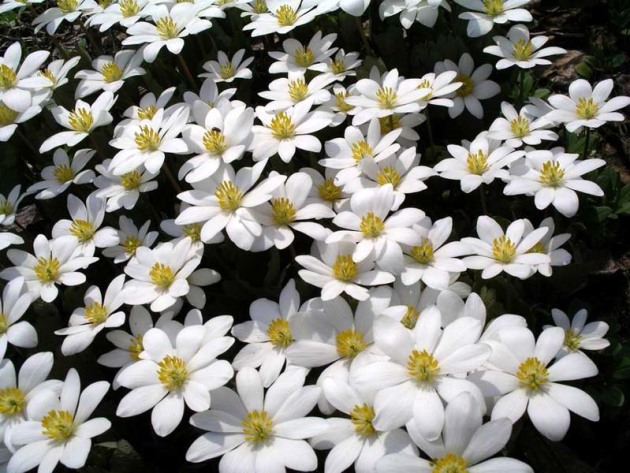
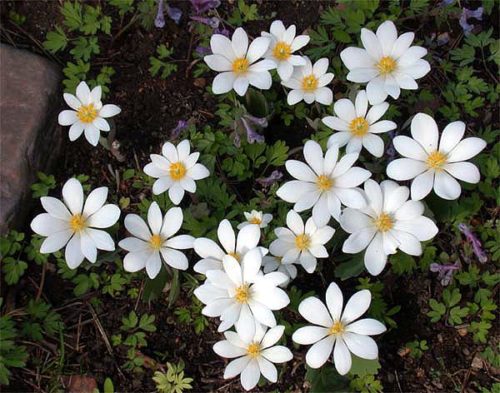
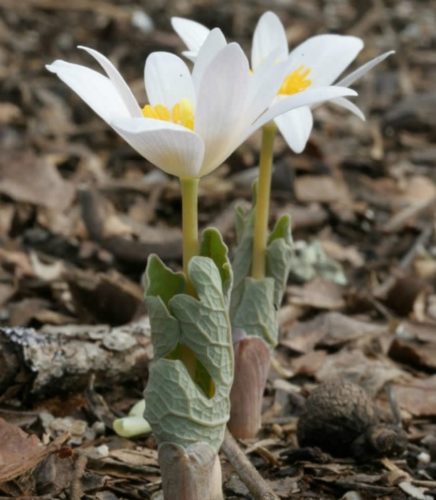
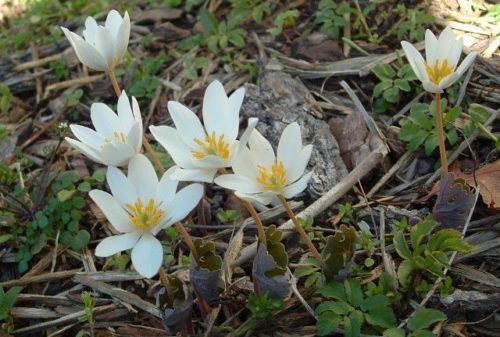
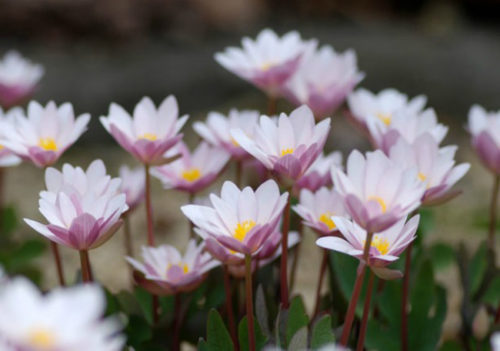
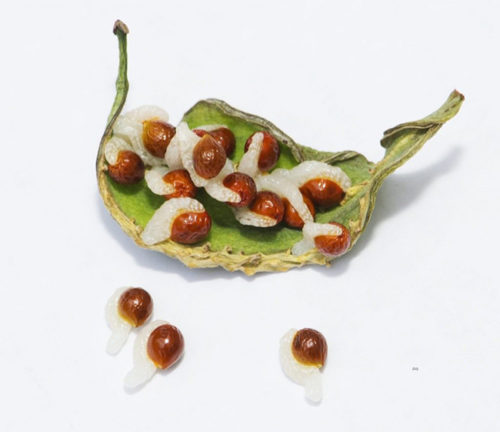
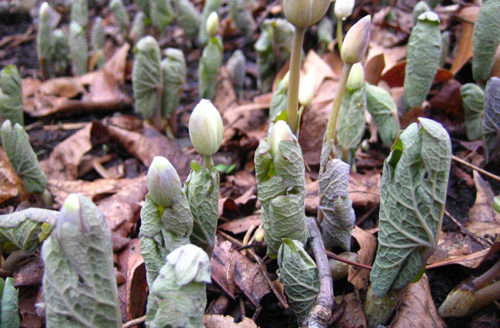
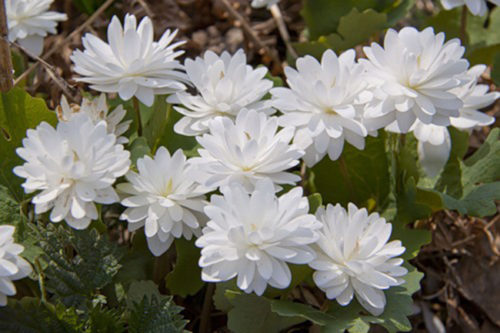
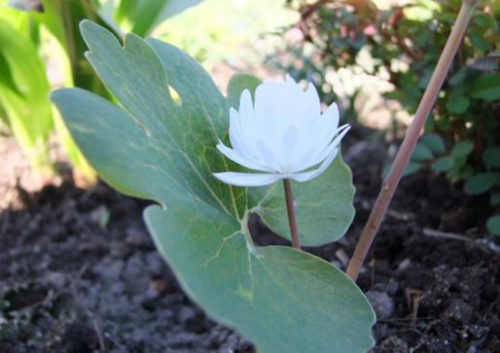

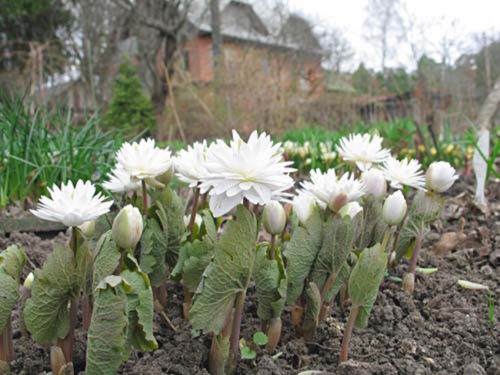
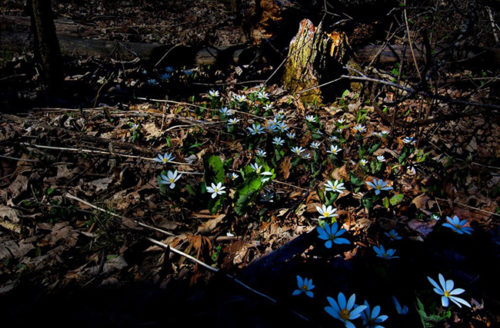

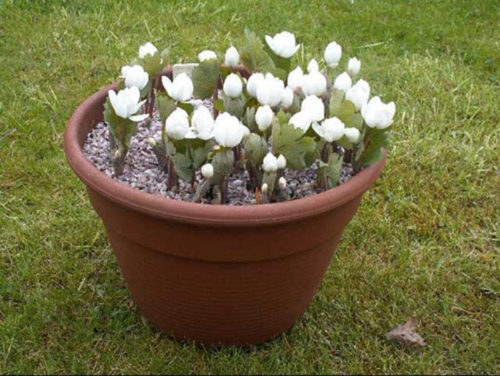
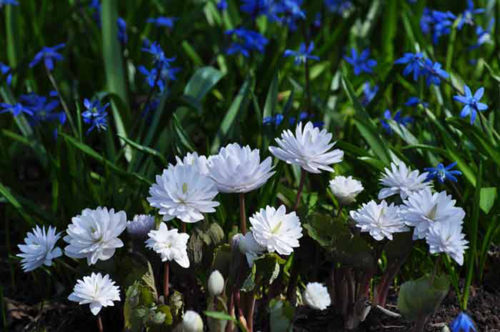
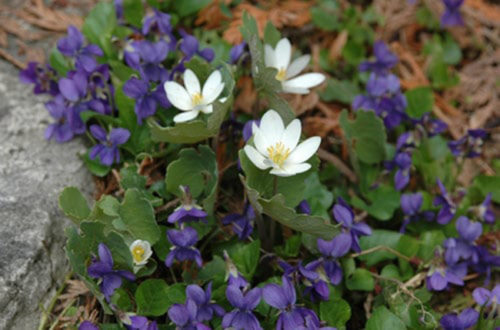













 Start a discussion ...
Start a discussion ...